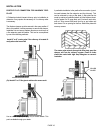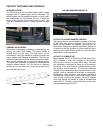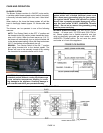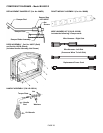
MAINTENANCE
PAGE 16
DOOR / GLASS GASKET AND ASH DUMP GASKET
A 3/4" spun fiberglass gasket provides the seal around
the fuel door and a flat spun fiberglass rope gasket (1/8”
x 1”) provides the seal around the glass. If the optional
ash drawer is installed, a cerawool pad (4 1/4” x 8 3/8” x
1/2”) provides the seal for the ash dump cover. Should
these gaskets become frayed or damaged, they should
be replaced with the same size and type as the original
gasket. Contact your dealer for ordering. Use high tem-
perature silicone sealer as an adhesive for replacing
door and ash dump gaskets. The glass gasket has a
self-adhesive backing.
WARNING: The gaskets must be kept in good condi-
tion. Do not leave the stove burning with the fuel
door open or ash dump cover off. This will cause
excessive heat build up in the unit and could ignite
surrounding combustibles as well as damage the
stove by overfiring it. Overfiring is a condition where
excessive temperatures are reached, beyond the de-
sign capabilities of the stove (such damage is not
covered by the manufacturer's warranty).
SERVICING GLASS
CAUTION: Be careful not to abuse door assembly by
striking or slamming it. If the door assembly or glass is
broken or damaged, they must be replaced before heater
can be safely operated. Use only components provided
by the manufacturer as replacement parts. Cleaning
Glass: Ensure stove is cold prior to cleaning glass. A
commercial glass cleaner designed for stoves is recom-
mended. Do not use abrasive cleaners.
Replacing Glass:
1. Remove door from stove by lifting door up and off
hinge pins: Place the door on a flat protected (towel)
clean flat surface with the inside of the door facing up.
Remove the glass clips (by removing screws holding
clips), then carefully remove broken glass one piece
at a time (protective gloves are recommended).
2. Clean area where the glass with gasket will be in-
stalled.
3. Install new glass with gasket (use only factory 5-mm
glass with glass channel gasket. Do not substitute).
Carefully reinstall glass clips. Be very careful not to
overtighten screws.
4. Reinstall door.
CREOSOTE FORMATION AND NEED FOR REMOVAL
What is Creosote - When wood is burned slowly, it pro-
duces tar and other organic vapors, which combine with
expelled moisture to form creosote. The creosote vapors
condense in the relatively cool chimney flue of a slow-
burning fire. As a result, creosote residue accumulates
on the flue lining. When ignited this creosote makes an
extremely hot fire. Also, creosote deposits tend to form in
long runs of venting where gases become too cool prior
to exhausting. Note: Single wall pipe cools rapidly, there-
fore installations using this type of flue are more suscep-
tible to creosote deposits.
To inhibit the build up of creosote, adjust the primary air
control to a medium-high or high setting for a 10-minute
period each day. Do not attempt to burn out heavy creo-
sote accumulations in this manner. This must be re-
moved from the chimney by scraping or brushing to re-
duce the risk of a chimney fire.
Burn Approved Fuel Only - This stove is approved for
burning dry seasoned natural wood only. Using green or
inadequately seasoned wood may increase creosote
buildup.
Inspection Frequency - The chimney connector and
chimney should be inspected at least twice monthly dur-
ing the heating season to determine if a creosote buildup
has occurred. If creosote has accumulated it should be
removed to reduce the risk of a chimney fire.
Cleaning - Remove the catalytic combustor and open
the bypass damper prior to having your chimney cleaned
(should be done by a qualified chimney sweep). See
Maintenance, Catalytic Combustor, on page 17 for in-
structions on removing catalytic combustor.
IMPORTANT: Make sure the bypass damper is in the
open position prior to chimney cleaning.
In the event of a chimney fire - Make sure the fuel door
is securely closed. Adjust the primary air control to the
lowest (most closed) setting. Call the fire department
immediately. After a chimney fire, the complete chimney
system should be checked by a qualified technician be-
fore further use.
Consult your dealer for suggestions on proper chimney
care. Contact your local municipal or provincial fire au-
thority for information on how to handle a chimney fire.
Have a clearly understood plan for handling a chimney
fire.
CATALYST REPLACEMENT
The normal expected life of a catalytic combustor is
10,000 to 12,000 hours (if appliance is operated correctly
and proper fuels are used). If the catalyst has been de-
activated, it should be replaced. Symptoms of deactiva-
tion include – noticeably darker smoke exiting chimney
and less heat output. If these symptoms remain after
normal maintenance or a major cleaning (soak in heated
vinegar / water solution, see page 17), the catalyst
probably needs replacement. Also, if the catalyst is bro-
ken and/or missing large pieces, it should be replaced.
Note: The catalyst does not need to be glowing to be
working. It will glow at times, but it can work very effec-
tively at temperatures well below the 1000° F level at
which it will begin to glow.


















